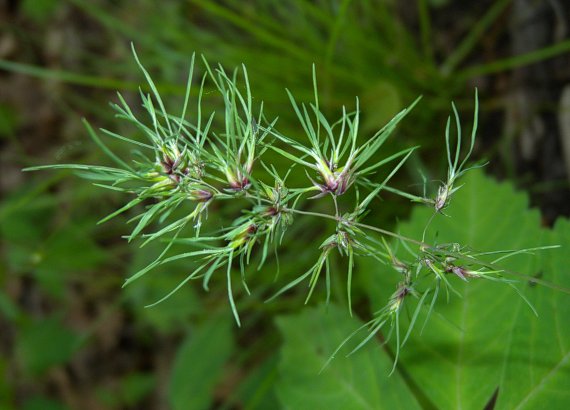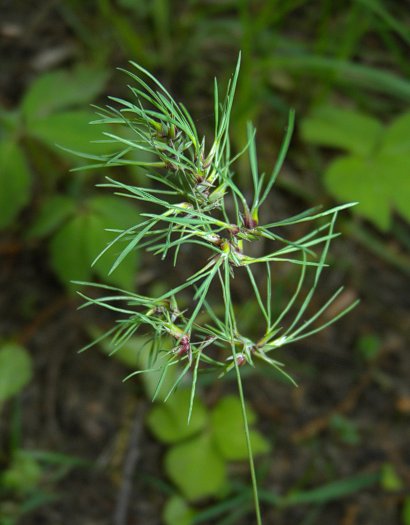
Each culm terminates in an ovoid to oblongoid panicle of spikelets or aerial bulblets. The typical panicle is 1½-4" long and 1-1½" across; it has a slender central stalk (rachis) and whorls of 2-3 wiry lateral branches that are more or less horizontal below and ascending above. The lateral branches often divide into secondary branches that terminate in either flattened spikelets or clusters of scaly bulblets; both spikelets and bulblet clusters have short pedicels. Individual culms can produce all spikelets, all bulblets, or a mixture of the two. In Illinois, most culms produce only bulblets. When spikelets are produced, they are 4-6 mm. long, consisting of a pair of glumes at the bottom and 2-6 lemmas above that have perfect florets. The glumes and lemmas are arranged into two ranks that are columnar and overlapping. The narrow glumes and lemmas are keeled; the glumes are 2-3.5 mm. long, while the lemmas are 2.5-3.5 mm. long. In each spikelet, one glume is a little longer than the other. Each lemma has a midvein along the keel and 2 marginal veins that are minutely pubescent, at least along the lower half of each vein (requires 10x magnification to see). Individual florets have 3 stamens and a pair of feathery stigmata.

The aerial bulblets are about 1/4" (6 mm.) long and 1/8" (3 mm.) across; they have purple bases and greenish purple or greenish white scales (modified lemmas). At the apex of each bulblet, one or more aerial basal leaves are produced that are green and narrowly linear in shape; they are up to 1" long. Each cluster of aerial bulblets has a pair of glumes underneath that are lanceolate and slightly succulent. When spikelets are produced, the blooming period occurs during late spring or early summer. The florets are wind-pollinated. In Illinois and other areas of North America, relatively few spikelets produce grains. Aerial bulblets also develop during the late spring and early summer; they become mature later in the summer, becoming detached from the mother plant. By forming rootlets in the ground, the bulblets are capable of forming new clonal plants. The root system of a plant consists of a terrestrial bulb with secondary fibrous roots below. New bulbs are often produced below ground as vegetative offsets.
Cultivation: Full sun to light shade, moist to dry conditions, and soil containing sand, loam, clay, or gravel provide acceptable conditions for growth and development, which occur primarily when the weather is cool during the spring
Range & Habitat: The non-native Bulbous Bluegrass is uncommon in Illinois, occurring in widely scattered areas. However, it is likely that this Eurasian grass will become more common in the future. Bulbous Bluegrass was introduced deliberately into the United States to be used as a possible turf grass; it also may have been introduced accidentally as a contaminant in grass and clover seed. Habitats include weedy meadows, lawns, abandoned fields, roadsides, areas near parking lots, thin woodlands, and waste areas. Degraded habitats with a history of disturbance are preferred.
Faunal Associations: Insects that feed on bluegrasses (Poa spp.) include Leptoterna dolobrata (Meadow Plant Bug) and other plant bugs, the planthopper Delphacodes campestris, Schizaphis graminum (Greenbug), and other aphids. Many grasshoppers eat the foliage of bluegrasses; they include Aeropedellus clavatus (Club-Horned Grasshopper), Arphia sulfurea (Sulfur-Winged Grasshopper), Eritettix simplex (Velvet-Striped Grasshopper), Melanoplus foedus (Striped Sand Grasshopper), and Melanoplus sanguinipes (Migratory Grasshopper). Other insect feeders include the caterpillars of the butterflies Cercyonis pegala (Common Wood Nymph) and Megisto cymela (Little Wood Satyr); also the caterpillars of several skippers, including Amblyscirtes hegon (Pepper-and-Salt Skipper), Amblyscirtes vialis (Common Roadside Skipper), Poanes hobomok (Hobomok Skipper), and Polites peckius (Peck's Skipper). Moth caterpillars that feed on bluegrasses include Feltia jaculifera (Dingy Cutworm), Nephelodes minians (Bronze Cutworm), Parapediasia teterrella (Bluegrass Webworm), Pediasia trisecta (Sod Webworm), Phalaenostola larentioides (Black-Banded Owlet), and Thioptera nigrofimbria (Black-Bordered Lemon Moth). Among these moth species, caterpillars of the Black-Banded Owlet feed on dead leaves. Because the aerial bulblets of Bulbous Bluegrass contain abundant starch and some fat, they are a useful source of food to many vertebrate animals, including elk, deer, sheep, upland gamebirds, deer-mice, and ground squirrels. Young foliage of Bulbous Bluegrass is palatable to rabbits and hoofed mammalian herbivores during the spring.

Photographic Location: Underneath some trees that were adjacent to a parking lot at the Oak Openings Nature Preserve in NW Ohio.
Comments: Like some species of onion and garlic (Allium spp.), Bulbous Bluegrass produces aerial bulblets. Unlike many bulblet-producing species of onion or garlic, this grass has flattened leaves that are not hollow, and it lacks the distinctive scent of these species. Because other grass species in Illinois don't produce aerial bulblets, Bulbous Bluegrass can be easily distinguished from them whenever its bulblets are present.